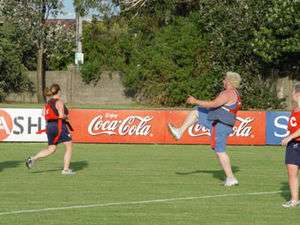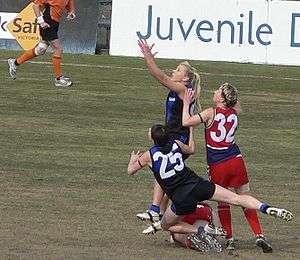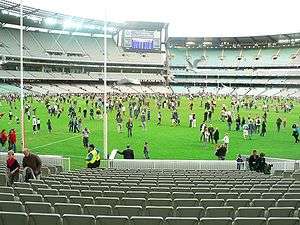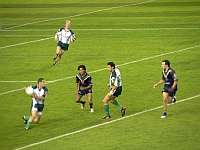Variations of Australian rules football
Variations of Australian rules football are games or activities based on or similar to the game of Australian rules football, in which the player uses common Australian rules football skills. They range in player numbers from 2 (in the case of kick-to-kick) up to the minimum 38 required for a full Australian rules football.

Some are essentially identical to Australian rules football, with only minor rule changes, while others are more distant and arguably not simple variations but distinct games. Others still have adapted to the unavailability of full-sized cricket fields. Other variations include children's games, contests or activities intended to help the player practice or reinforce skills, which may or may not have a competitive aspect.
Most of the variations are played in informal settings, without the presence of umpires and sometimes without strict adherence to official game rules.
Participatory varieties
Auskick
Auskick is a national program in Australia to develop and promote participation in Australian rules football amongst children. It has proven to be popular with both boys and girls.
The program, devised in 1998 and begun in Victoria under the name "Vickick", it was supported by the Australian Football League, the national professional competition for the sport, which began to roll it out nationally. It has also seen variations overseas, including Viking Kick (Denmark).
Women's Australian rules football

Women's Australian rules football (also known as Women's Aussie Rules, Women's footy, Women's AFL or in areas where it is popular, simply "football") is a fast-growing sport.
Although it is a contact sport, women's Australian rules is sometimes played with modified rules. It is less brutal on the body than women's American football, women's rugby league or women's rugby union and offers more physicality than women's soccer, as well as requiring both hand and foot co-ordination. It is a fast-paced team sport and is played by women of all shapes and sizes.
The game is played at senior level in Australia, the United States, England, New Zealand, Canada and Japan. At junior level, it is also played in Papua New Guinea, Argentina and South Africa. At schoolgirls level, it is also played in Tonga and Samoa.
Masters Australian Football
Masters Australian Football (also known as "Superules") is a sport based on Australian rules football for players aged 35 years and over. The sport first commenced officially on 21 September 1981, after being founded by John Hammer in 1980 in Nhill, Victoria.
Modifications to the rules reduce the physical impact of the game for older players. It is played by over 119 teams throughout Australia and around the world.
The variation to the game is also dubbed "Superfools" by some followers and players.
Lightning football
Lightning football is a generic term to describe variations of the game played over a shortened length, usually about half of the length of a full match. Lightning football may be played under otherwise unchanged rules, but in recent lightning matches staged by the AFL, experimental rules such as awarding a free kick against the last player to touch the ball before it goes out of bounds have been trialled.
Lightning matches are often used, particularly at junior or amateur level, to play an entire tournament inside a single day or weekend. These tournaments are typically known as "lightning premierships" or "lightning carnivals".
Modified field or player numbers
9-a-side
9-a-side Footy is played informally by Aussie Rules clubs but not yet an official sport in its own right.
9-a-side games are sometimes played on half size fields that are typically rectangular with 9 players on the field at any one time, typically consisting of three forwards, three backs and three centre players. Often two games are played at the same time on a single Australian rules or cricket field. At other times, 9-a-side makes use of the full space of the field when a full complement of players is not available. This variety is a more open and running variety of Australian rules.
A minimum of 18 players are required in total, but many teams field unlimited interchange benches.
Rules are the same as Australian rules football. Limited and non-contact versions of 9-a-side football are also played by both men's and women's leagues.
Examples of official tournaments held under these rules include the EU Cup and Bali Nines.
Samoa Rules
Samoa Rules is a game derived from Australian rules football that has also been played in Samoa. The game is played on rugby fields and each team consists of 15 players per side.
Unlike Australian rules football, player movement is restricted to zones (similarly to Rec Footy). There is a line across the centre that backs and forwards can not cross. Onballers are allowed to go anywhere.
The Vailima Six-Shooters' Championship began in Samoa in 1998 under these rules, becoming known as "Samoa Rules". A number of Samoa Rules players went on to represent Samoa in the Samoan national Australian rules football team, known as the "Bulldogs".
Metro Footy
Metro Footy (or Metro Rules Footy) is a modified version of Australian rules football rules played on gridiron football, rugby or Association football fields, predominantly in the United States of America. The reasons for the development of Metro Footy was partly due to there being few grounds large enough for traditional Australian rules matches, but also to allow competitive football to be played with smaller playing numbers, allowing for better recruitment possibilities.
Teams typically consist of 9-a-side on a 110-by-50-metre (120 yd × 55 yd) field. The teams that play feed into larger 18-a-side Australian rules representative teams that participate in leagues such as the MAAFL or tournaments such as the USAFL National Championships and also provide the opportunity to introduce new American players to the game of Australian rules football.
Several clubs from the United States Australian Football League participate in Metro Footy.
AFLX
Another prominent variation of the game is AFLX, an official Australian Football League sanctioned pre-season event. The game is played on soccer-sized pitches and features seven players a side, as well as several other rules designed to speed up the game.[1]
Historical variations
VFA rules (1938–1949)
VFA rules (or "Association rules" or "throw-pass rules") variation of Australian rules football was a distinct set of rules which was played in the Victorian Football Association, and several other smaller competitions which elected to switch to the new rules, between 1938 and 1949. Although there were several other small differences between the VFA's rules and the national rules, the primary distinguishing feature was that throwing the ball from below the shoulders with two hands was a legal form of handpass – known as a throw-pass – under the VFA's rules. The ease of throw-passing compared with traditional handpassing resulted in the VFA's code fostering a faster playing style with fewer stoppages and more run-and-carry than was seen under the traditional rules at the time. The VFA's code operated as a rival to the national code throughout the 1940s, and some innovations of the VFA's code were incorporated into the national code over that time. The VFA reverted to playing under the national rules from the 1950 season, and the throw-pass rules have not been seen since.
Recreational varieties

Rec Footy
Recreational Football (also known as Rec Footy or Recreational Footy) is a non-contact version of the Australian rules football game sanctioned by the Australian Football League. It is a more accessible version of Australian rules football that people can pick up and play with some degree of skill and ability and it is directly aligned to the traditional game of Australian rules football. It is a mixed competition, accessible to players of both sexes, all shapes and sizes and requires minimal equipment to play, but is suitable only for those above Auskick age.

Kick-to-Kick
Kick-to-kick is a pastime, a well-known tradition of Australian rules football fans, and a recognised Australian term for kick and catch type games. A common format is for one person in a group to kick to a second group; whoever marks the ball kicks it back to the first group. In its "markers up" form, it is the usual casual version of Australian rules (similar to the relationship between backyard/beach cricket and the established forms of cricket).
Although not a sport in itself, the term is used to describe a social exercise played in parks, fields, streets and back yards, and requires at least two people.
Touch Aussie Rules
Touch Aussie Rules is a non-tackle version of Australian rules football that is currently played in London, UK and organised by Aussie Rules UK.
All skills are used in Touch Aussie Rules, including kicking, marking, handballing and bouncing.
Hybrid codes
International Rules Football
International rules football (Irish: Peil na rialacha idirnáisiunta; also known as inter rules in Australia and compromise rules in Ireland) is a hybrid code of football, which was developed to facilitate international representative matches between Australian rules football players and Gaelic football players and is played between them worldwide.
Austus
Austus is a sport which was started in Australia during World War II when United States soldiers wanted to play football against the Australians. The game combined features of Australian rules football and American football. The rules of the game were mostly the same as Australian rules football, except that the American-style forward pass was allowed and afforded the same benefits as an Australian rules football kick, meaning that a thrown ball could be marked or used to score goals.[2] The name comes from the first four letters of Australia (AUST) and the initials of the United States (US). The game has rarely, if ever, been played since the war.
Samoan rules
A hybrid of rugby union and Aussie rules.
Universal Football
Universal football was a proposed hybrid sport of Australian rules football and rugby league, as a means of unifying Australia under a single dominant football code. First codified in 1914, the game was originally designed to be played by teams of 15 on rectangular fields with rugby-style goalposts featuring a crossbar. The off-side rules of rugby league applied within in the forward quarter of the ground and did not apply elsewhere. Handpasses, which included throws, could only be made backwards. Rugby scrums were eliminated and replaced with the Australian rules football style ball-up. Players could be tackled anywhere between the knee and the shoulders. The Australian rules style of mark was kept. Tries were worth three points, conversions and goals from marks kicked over the crossbar were worth one point, and goals kicked on the run were worth two points.[3][4]
There was some progress towards amalgamating the two sports in 1915, but these were halted by the escalation of World War I[5] and the new code was not revived after the war ended.[6] The concept was briefly revisited in 1933 with similar rules, and a private trial match was played at the Sydney Showground,[7] but it did not result in a lasting revival of the concept[8] which has not been seen since.
References
- "AFLX revealed: Who your club plays". AFL.com.au. 17 November 2017.
- "On play and players". The Sporting Globe. Melbourne, VIC. 21 July 1943. p. 13.
- The Cynic (25 November 1914). "Suggested universal football game". Referee. Sydney, NSW. p. 16.
- "Rival football games". Barrier Miner. Broken Hill, NSW. 21 November 1914. p. 8.
- "Annual meeting of the league – the proposed universal code". The Mercury. Hobart, TAS. 30 March 1915. p. 8.
- "Australian Football Council". The Age. Melbourne, VIC. 30 December 1919. p. 7.
- "The new game – trial matches in Sydney". Advocate. Burnie, TAS. 12 August 1933. p. 7.
- "To be dropped – proposed amalgamation – football codes". Newcastle Morning Herald and Miners' Advocate. Newcastle, NSW. 15 August 1933. p. 8.
